Sacramento Perch
-
Scientific NameArchoplites interruptus
-
NativeNative Species
-
Identification
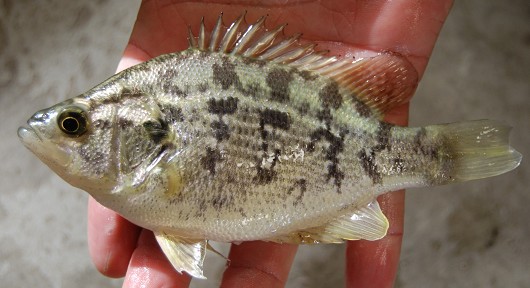 Sacramento perch, juvenile (5 months old). Crowley Lake strain, reared at Contra Costa Mosquito & Vector Control District, CA. FL = 131 mm. Photographed on 11/19/09 by Chris Miller, CCMVCD. Note: This fish is a cannibal and grew very fast.
Sacramento perch, juvenile (5 months old). Crowley Lake strain, reared at Contra Costa Mosquito & Vector Control District, CA. FL = 131 mm. Photographed on 11/19/09 by Chris Miller, CCMVCD. Note: This fish is a cannibal and grew very fast.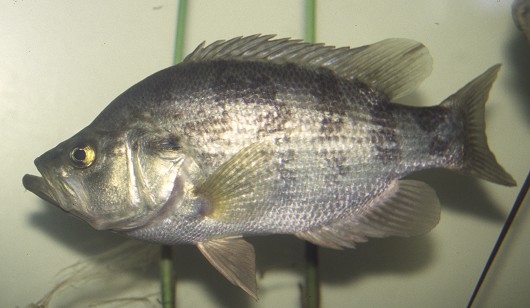 Sacramento perch, adult male. Captured from Sindicich Lagoon, Martinez, California in May 2001. SL = 238 mm. Photo by Chris Miller, Contra Costa Mosquito & Vector Control District, California.
Sacramento perch, adult male. Captured from Sindicich Lagoon, Martinez, California in May 2001. SL = 238 mm. Photo by Chris Miller, Contra Costa Mosquito & Vector Control District, California.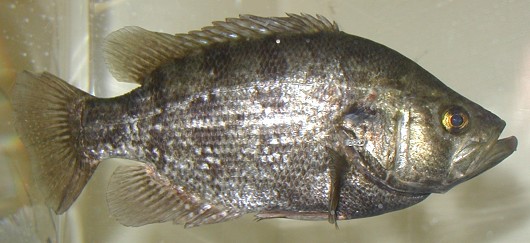 Sacramento perch (probably a breeding male, based on dark color). Captured from Sindicich Lagoon, Martinez, CA in May 2001. SL = 221 mm. Weight = 260 g. Photo by Chris Miller, Contra Costa Mosquito & Vector Control District, CA.
Sacramento perch (probably a breeding male, based on dark color). Captured from Sindicich Lagoon, Martinez, CA in May 2001. SL = 221 mm. Weight = 260 g. Photo by Chris Miller, Contra Costa Mosquito & Vector Control District, CA.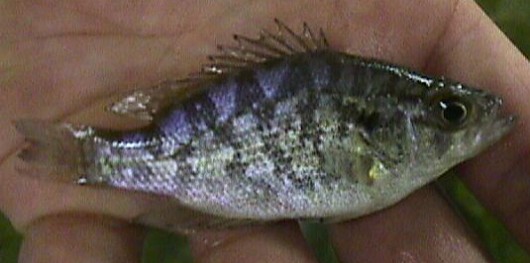 Sacramento perch, juvenile (170 days old). Raised from wild brood fish from Sindicich Lagoon, Concord, California. SL = 68 mm. Photographed in January 2002 by Chris Miller, Contra Costa Mosquito & Vector Control District, California.
Sacramento perch, juvenile (170 days old). Raised from wild brood fish from Sindicich Lagoon, Concord, California. SL = 68 mm. Photographed in January 2002 by Chris Miller, Contra Costa Mosquito & Vector Control District, California.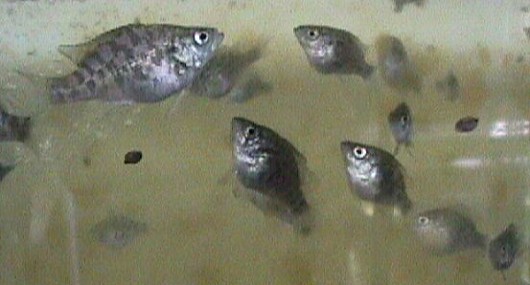 Sacramento perch, juveniles (107 days old). Raised from wild brood fish from Sindicich Lagoon, Concord, CA. Average SL = 32 mm. Photographed in October 2002 by Chris Miller, Contra Costa Mosquito & Vector Control District, CA.
Sacramento perch, juveniles (107 days old). Raised from wild brood fish from Sindicich Lagoon, Concord, CA. Average SL = 32 mm. Photographed in October 2002 by Chris Miller, Contra Costa Mosquito & Vector Control District, CA.- Deep bodied (depth up to 2.5 times SL), laterally compressed, max. 61 cm TL (3.6 kg)
- Large and oblique terminal mouth, maxilla extends to middle of eye
- Teeth present on jaws, tongue, and roof of mouth
- Coloration: brown sides and back with metallic green to purple sheen, white underside, 6-7 vertical bars on sides, black spot on opercula
- Breeding males: darker than normal, opercula purple, silvery spotting
- Breeding females: uniform coloration
- Fin spines/rays: dorsal 12-14 spines/10-11 rays, anal 6-8 spines/10-11 rays, pectoral 13-15 rays
- Lateral line scales (large): 38-48
-
Life History
Sacramento perch were historically abundant predators throughout the Central Valley of California, where they occupied sloughs, lakes, and slow moving rivers. Today they are rare in their native waters, but still exist in Clear Lake and Alameda Creek/Calaveras Reservoir, as well as in some farm ponds and reservoirs. They have been introduced through the state including the upper Klamath basin, upper Pit River watershed, Walker River watershed, Mono Lake watershed, and Owens River watershed, and may exist in Sonoma Reservoir in the Russian River watershed. Sacramento perch are most often found in warm reservoirs and ponds where summer temperature range form 18-28°C. Sacramento perch are capable of surviving high temperatures, high salinities (up to 17 ppt), high turbidity, and low water clarity. Though Sacramento perch are often found in clear water among beds of aquatic vegetation, they achieve greater numbers in turbid lakes absent of plants. Typically they are found along the bottom of inshore regions. Young-of-year perch form shoals in these areas where aquatic and overhanging vegetation provide cover. Sacramento perch are most abundant where other centrarchids are absent. They feed by stalking, and prey items vary with time, availability, and fish size. Sacramento perch are opportunistic and feeding occurs all day with peaks at dawn and dusk. Their diet is more diverse in summer than in winter. Young-of-year fish feed primarily on small crustaceans found on plants and in the substrate. Juvenile perch in Clear Lake were found to feed mostly on copepods and later cladocerans. Aquatic insect larvae and pupae become increasingly important as the fish grow. Adult fish may begin to feed on other fish, including young-of-year perch. Growth is variable and factors such as diet, overcrowding, and gender affect growth rates. Females tend to be larger than males and adult fish grow more in weight than in length. Sacramento perch reach sexual maturity in year 2 or 3 and generally spawn from March through early August when water temperatures range from 18-29°C. Prior to spawning, perch gather in shallow areas abundant with filamentous algae and macrophytes. These assembly areas may also have submerged roots, rock piles, and sticks. Male fish begin defending territories along shore where they create shallow nests. They vehemently defend their space until the arrival of a female perch, at which time they begin courting. The male and female perch release eggs and milt simultaneously, and upon completion the female perch abandons the nest. Females spawn with multiple males, producing a total of about 8,400-125,000 eggs. Egg production varies with body size. Male perch guard their nests and the embryos for several days. The emergent larvae are planktonic for a time period assumed to be about 1-2 weeks.
-
Links to Other ResearchN / A
-
Watershed
-
Crowley Lake Watershed
-
East Walker Watershed
-
Honey-Eagle Lakes Watershed
-
Lost Watershed
-
Lower Sacramento Watershed
-
Mono Lake Watershed
-
North Fork Feather Watershed
-
Owens Lake Watershed
-
Panoche-San Luis Reservoir Watershed
-
Russian Watershed
-
San Francisco Bay Watershed
-
Tomales-Drake Bays Watershed
-
Upper Cache Watershed
-
Upper Klamath Watershed
-
Upper Pit Watershed
-
West Walker Watershed
-
Please note, watersheds are at the USGS 8-digit Hydrologic Unit Code (HUC) scale, so they often include a lot of sub-watersheds. If a species occurs in any sub-watershed within the HUC, the species appears within the HUC. Link to an EPA page that shows HUCs.




